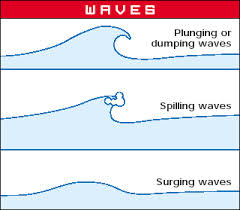

south-west winds have a longer fetch and cause larger and more powerful waves.south-east winds have a shorter fetch and cause smaller waves.On the south coast of England, south-east winds (ones originating from the south-east and heading north-west), have less open sea across the English Channel than south-west winds blowing in from the Atlantic Ocean. How steeply a beach slopes or shelves and the topography of the sea bed near the beach will also affect the size and type of wave. how far the wave has travelled (known as the fetch).The size and power of a wave is influenced by three main factors: Depending on which is stronger, waves can be either constructive or destructive. The movement of a wave up the beach is known as the swash, its movement down the beach is known as the backwash. They can also be caused by seismic activity. Waves are formed by friction when the wind blows across the surface of the sea, causing a swell as water particles rotate and move forwards. One of the crucial elements of sea safety and for anyone who visits the coast, is to know the basics about waves so that they can keep themselves and others safe. They are one of the most exciting and impressive features of our UK and Irish coastlines and they are the primary force shaping coastal change. Powerful breaking waves have the potential to bring out the big kid in all of us. News and Features Expand menu - News and Features.Find my nearest Expand menu - Find my nearest.

Give feedback on our education resources.Plan and register your fundraising event.The ebb and flow of waves and tides are the life force of our world ocean.

Waves caused by the gravitational pull of the moon and the sun are called tides. Waves transmit energy, not water, and are commonly caused by the wind as it blows across the ocean, lakes, and rivers. The cause of tsunamis are not related to tide information at all but can occur in any tidal state. It is a common misconception that a tidal wave is also a tsunami. These waves are tides or, in other words, tidal waves. The gravitational pull of the sun and moon on the earth also causes waves. These waves roll upon the shore like a massive sea level rise and can reach far distances inland.

Storm surge and tsunamis are not the types of waves you imagine crashing down on the shore. These very long waves are called tsunamis. Other hazardous waves can be caused by underwater disturbances that displace large amounts of water quickly such as earthquakes, landslides, or volcanic eruptions.
Types of ocean waves series#
The strong winds and pressure from this type of severe storm causes storm surge, a series of long waves that are created far from shore in deeper water and intensify as they move closer to land. More potentially hazardous waves can be caused by severe weather, like a hurricane. As wind blows across the surface of the ocean or a lake, the continual disturbance creates a wave crest. These types of waves are found globally across the open ocean and along the coast. Wind-driven waves, or surface waves, are created by the friction between wind and surface water. However, water does not actually travel in waves. Waves transmit energy, not water, across the ocean and if not obstructed by anything, they have the potential to travel across an entire ocean basin. Waves are created by energy passing through water, causing it to move in a circular motion. Whether observing from the beach or a boat, we expect to see waves on the horizon.


 0 kommentar(er)
0 kommentar(er)
